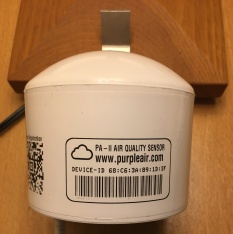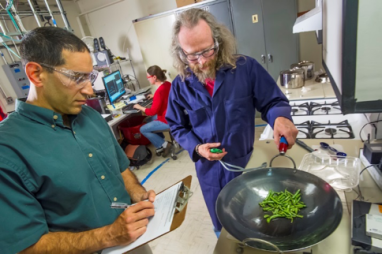Repost from Energy Institute at Hass Business School, Berkeley CA
[You can order a Purple Air Monitor here – $229 for an outdoor monitor, $179 for an indoor monitor.]
My New Pollution Monitor: Gimmick or Game Changer?
By Meredith Fowlie, January 2, 2019
The sensor revolution takes on air pollution
A few months ago, our family invested in our own air quality monitor. This little sensor has made invisible air pollution visible. And it’s changing the way we think about the air we breathe.

Turns out, we’re not the only ones geeking out on home pollution monitoring. Here in California, private citizens have deployed more than three times as many air pollution sensors as the government agencies charged with the task of monitoring our air quality. The graph below tracks the adoption of PurpleAir monitors like ours in Northern California.

PurpleAir Monitor adoption in Northern California: 2017-2018. The graph shows how the devastating Camp Fire in Northern California was good for PurpleAir business. Thanks to Duncan Callaway for scraping these data.
Filling the monitor gaps
Once connected to Wi-Fi, privately owned PurpleAir devices feed into a global network and data are displayed in real time on a cool map. This enables a kind of public crowdsourcing of air quality information– an important shift away from the status quo.
State and Federal government agencies have traditionally been the primary/only source of air quality data. Public provision makes sense because we all benefit when people can access reliable air quality information. And if the benefits are shared by everyone, it follows that the costs should be shared as well.
But the high costs of monitoring have limited the scale of the public monitoring network. A single EPA air pollution monitor can cost as much as $100,000 to install and requires skilled staff to operate. On account of these high costs, there are fewer than 1000 regulatory grade air quality monitors measuring PM2.5 –the ultrafine particles that pose the greatest health risk –in the entire United States.
Sparse monitoring would not be a big issue if pollution concentrations didn’t vary much over space. But exposure to pernicious local pollutants like PM2.5 can vary significantly over short distances. If you live far from an EPA monitor, the crud in the air you’re breathing can be very different from the measurements used to monitor and enforce air quality regulations.
The upshot is that spatial gaps in the regulatory monitoring network leave wide gaps in our understanding/monitoring of air quality. Cue the low-cost, “consumer-grade” sensor revolution. Companies like PurpleAir, Atmotube, and Plume Labsare putting air pollution monitors in the hands of private individuals and community organizations. And these little sensors are starting to fill some big gaps.
The map on the right plots the government-operated, regulatory-grade monitors where I live (the Bay Area). The map on the left is a recent snapshot of monitor readings from Wi-Fi connected PurpleAir monitors in the same area. Wow.

Air pollution monitors in my neighborhood. PurpleAir sensors (left) and regulatory –grade monitors (right)
You might be concerned that you get what you pay for with these low-cost sensors. It’s true that PurpleAir sensors (and other consumer-grade sensors) use a different technology to count the tiny particulates in our air. Although this technology is not as reliable as regulatory grade monitors, our colleagues at the Lawrence Berkeley Lab have put these low-cost monitors to the test and found that PurpleAir sensors performed surprisingly well.
 Deep fried green bean pollution. Source
Deep fried green bean pollution. Source
Information Drives Action
Our PurpleAir sensor cost us $210. That’s a lot less than $100k, but not a small price to pay to collect our own personal air quality information. We had three reasons for making this investment:
1. Particulate pollution is hyper-local: Living 3 miles from the closest government monitor, we were curious to get a better read on the quality of the air our family breathes every day. We live far from a major road, so we are fortunate to breathe air that seems generally cleaner than the closest EPA monitor records for regulatory purposes. Others are not so lucky. Nearby (indoor) PurpleAir (PA) monitors located downwind of a major highway seem to read consistently higher.
2. We live indoors: Most of us spend most of our time indoors. It is, therefore, remarkable that the health effects of indoor air pollution are relatively poorly understood. Almost everything we know about the health effects of pollution exposure is based on outdoor pollution monitor measurements. Until we installed our PA monitor, I didn’t think much about indoor air quality.
My assumption was that if pollution particles are impossibly tiny, they must pass easily between indoors and outdoors. And so PM2.5 levels should be more or less the same indoors and out. Turns out that assumption is not quite right. The graph below plots hourly PM2.5 concentrations inside our house (blue) and at the closest outdoor PA monitor installed less than a mile away (orange).
 These data were downloaded from this PurpleAir website where you can access high-frequency monitor data from thousands of monitors around the globe. Thanks to PurpleAir for making these data so accessible!
These data were downloaded from this PurpleAir website where you can access high-frequency monitor data from thousands of monitors around the globe. Thanks to PurpleAir for making these data so accessible!
In the first couple of months after installing our sensor in September, particulate concentrations inside our house tracked outdoor air quality fairly well. But you can see instances when our air quality is worse than outdoors. Reasons include: stovetop popcorn, forgetting to run the stove vent while cooking dinner, and our third grader’s science experiment run awry.
But then came the Camp Fire in November. Northern California was mired in awful smoke for over a week. Outdoor particulate concentrations reached dangerous levels. Initially, our indoor air quality climbed in lock-step with outdoor air quality. But with the help of our PA monitor, we started experimenting. Real-time monitor feedback helped us figure out what was working (replacing our furnace filters and running the fan 24/7) and what was making things worse (running our kitchen stove vent which pulled outside air in). We managed to improve our indoor quality considerably while the outdoor air quality remained terrible.
3. Citizen science/environmentalism/data nerdism
When the government is the sole provider of air quality information, the government gets to choose where and how air quality gets measured. Recent research by some of our colleagues highlights some concerning aspects of the where and how of past air quality monitoring activities. As for the current administration, the Trump EPA has been working hard to downplay concerns about air pollution and reduce the stringency of air pollution regulations.
If you find all of this very concerning, a consumer-grade air pollution monitor gives you a way to increase the level of publicly available air quality information and scrutiny. Ever since we connected our monitor back in September, we’ve been transmitting high-resolution information on local air quality, displayed in real time via a user-friendly air quality map for all to see. The effect we are having may be incremental, but the aggregate impact of widespread adoption could be significant.
Gadget or Game Changer?
The growing popularity of low-cost sensors is exciting. But a few thousand sensors operated by the likes of me does not a revolution make. If these little sensors are going to be transformative, they’ll need to be more widely deployed. And the data need to be actionable so that people can understand where the most dangerous pollution problems manifest and how we might address them.
We’re already seeing some exciting grassroots and green shoots initiatives. In the year ahead, we should see a lot more. California’s AB 617 mandates that community-level air monitoring be put in place by mid-2019. To keep implementation costs manageable, low-cost sensors will likely play an important role. The specifics of that role still need to be worked out. Low-cost sensors are no perfect substitute for regulatory-grade monitors. But they could be important complements. If well-crafted policy implementation and community mobilization can catch up with sensor technology innovation, these cool gadgets could become a real game changer.





 Deep fried green bean pollution.
Deep fried green bean pollution. 